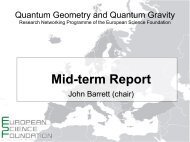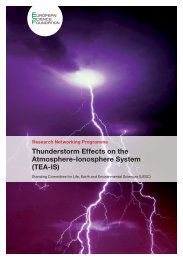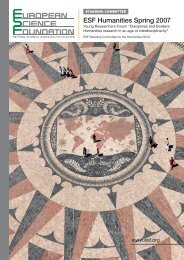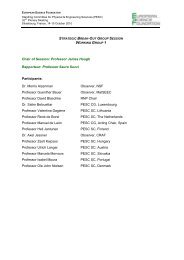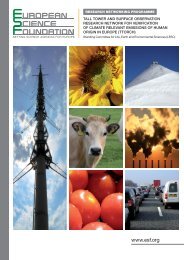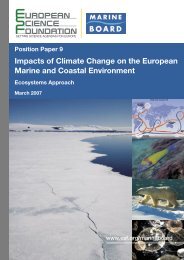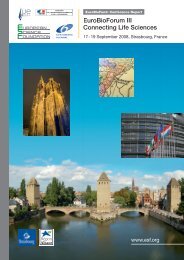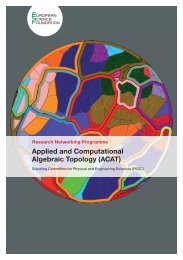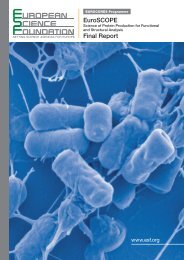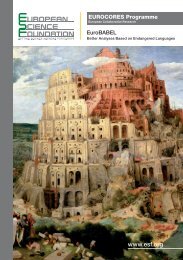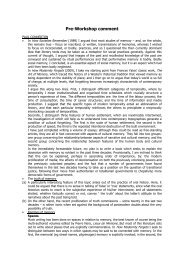European Peer Review Guide - European Science Foundation
European Peer Review Guide - European Science Foundation
European Peer Review Guide - European Science Foundation
Create successful ePaper yourself
Turn your PDF publications into a flip-book with our unique Google optimized e-Paper software.
only six organisations have indicated that they have<br />
programmes for the Creation or Enhancement of<br />
Scientific Networks 82 .<br />
the survey have indicated that they have preliminary<br />
selection, with one using outline proposals and the<br />
other based on full proposals.<br />
(iii) Responsive (continuous calls) versus<br />
non-responsive (time-bound calls)<br />
Because of their nature, it is usually preferable to<br />
consider the non-responsive mode for managing<br />
networking programmes, particularly for multinational<br />
programmes, since they require specific<br />
preparatory steps that need careful attention (e.g.,<br />
programmatic agreements, guidelines, dissemination<br />
needs, themes or domains of research, etc.).<br />
With regard to the language regime, it is common<br />
for proposals to be written in English. This is an<br />
important factor when proposals are submitted by<br />
multinational teams, and/or when the peer review<br />
will be carried out by international panels of experts.<br />
However, other national languages may be acceptable<br />
in the case of national network programmes,<br />
or multilateral collaborations involving a shared<br />
common language.<br />
The results of the survey show that for programmes for<br />
the Creation or Enhancement of Scientific Networks,<br />
from the six respondents, one has indicated a<br />
continuous call and four with calls at regular intervals,<br />
of 6 months (for 1/4 respondents) and 12 months (for<br />
3/4).<br />
7.2 Recommended peer review<br />
approaches specific to Scientific<br />
Network proposals<br />
In this section some of the specific features will<br />
be highlighted. Although there seems to be some<br />
degree of variability in the processes and the way<br />
these are applied across different scientific domains,<br />
the procedures suggested below are meant to apply<br />
across various domains.<br />
According to the survey, for the Creation or<br />
Enhancement of Scientific Networks, all six<br />
respondents have indicated that their procedures are<br />
the same across all disciplines.<br />
7.2.1 Proposal submission<br />
Calls may be organised on the basis of one- or twostage<br />
submissions. A two-stage process may be most<br />
appropriate when a high volume of proposals is<br />
expected (and a relatively low success rate).<br />
Other factors to be considered are the increased<br />
total time to a final grant, and the greater administrative<br />
effort required of the funding body. It is<br />
generally found that a single submission stage may<br />
be sufficient.<br />
For programmes for the Creation or Enhancement<br />
of Scientific Networks two of the six respondents of<br />
82. See <strong>European</strong> <strong>Science</strong> <strong>Foundation</strong> (2010b), ESF Survey Analysis<br />
Report on <strong>Peer</strong> <strong>Review</strong> Practices, in particular Section 4.1, Table 4.1.<br />
For the Creation or Enhancement of Scientific Networks<br />
programmes, three out of six organisations responded<br />
that English is used as the language of their calls and<br />
two organisations (33%) stated that they use their own<br />
country’s official language(s).<br />
As described in Part I of this <strong>Guide</strong> (Chapter 4) it<br />
is recommended good practice to provide detailed<br />
guidelines for applicants, describing the submission<br />
process, the rules of the game and explaining the<br />
subsequent steps in the selection process.<br />
7.2.2 <strong>Peer</strong> <strong>Review</strong> stages<br />
A two-stage evaluation process, which includes<br />
individual/remote reviewers (at least three) and a<br />
panel assessment, is usually is the most appropriate.<br />
However, for Scientific Network Programmes a single<br />
stage may be sufficient.<br />
Some variants can occur in the number and<br />
the typology of the reviewers as individual/remote<br />
(external) versus members of the review panel<br />
according to the type of proposals.<br />
For programmes for the Creation or Enhancement<br />
of Scientific Networks two out of the six survey<br />
respondents reported using a two-stage selection<br />
process: one utilises fully disjointed individual/<br />
remote reviewers and panel members, the other one<br />
sometimes allowing some overlap between the two sets.<br />
• Individual/Remote <strong>Review</strong>ers<br />
– Conventional proposals: the number can typically<br />
vary between three and four;<br />
– Interdisciplinary proposals: can require a higher<br />
number of individual/remote reviewers;<br />
– Breakthrough proposals: reviewers should be<br />
able to flag the transformative character of the<br />
proposed research;<br />
– Confidentiality: similar to the Collaborative<br />
Research programmes discussed in the previ-<br />
63<br />
<strong>European</strong> <strong>Peer</strong> <strong>Review</strong> <strong>Guide</strong>



